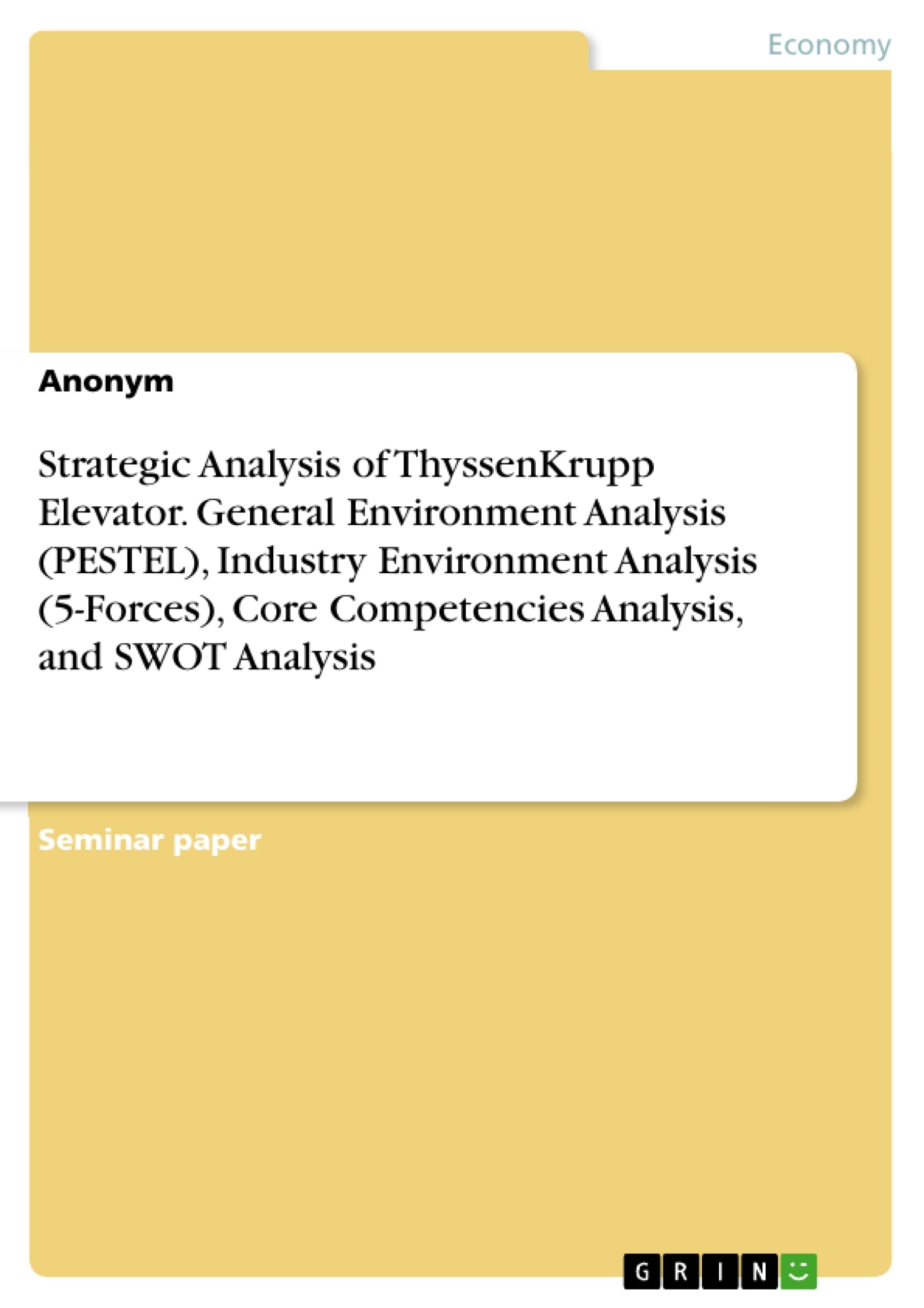This paper reviews and thoroughly analyses the strategy of ThyssenKrupp Elevator as a part of ThyssenKrupp AG group by implementing a variety of tools to analyse the impact of the external and internal environment on the company. It also reviews the current strategy and provides helpful general recommendations on how the company should proceed in order to reach global growth and benefit from the industry growth.
A vision statement describes the company´s directions and future for a life span of 10 to 20 years as well as it defines the long-term goals and represents the company´s philosophy which forms the reference for the company to break down challenges and achieve these goals. A mission statement is the core of a business which articulates the strategy used to achieve the company´s goals and objectives and defines target population and Company´s values as well as it guides the planning process.
Vision of ThyssenKrupp Elevator is defined as "Engineering confidence with everything we do" for the company to build trust among customers in terms of providing reliable and convenient passenger transportation systems for better flow of urban life and to make cities better place to live and to deliver the best people flow experience.
ThyssenKrupp´s mission revolves around engaging customers, employees, investors, and society to reach global markets and to ensure competency and diversity, creating value for employees, customers and shareholders, providing innovative products to create sustainable infrastructure, and as a customer-focused company, keeping employee health and workplace safety as a top priority.
Inhaltsverzeichnis (Table of Contents)
- Introduction
- History and Overview of ThyssenKrupp
- Scope of Work
- Mission and Vision of ThyssenKrupp
- General Environment Analysis (PESTEL)
- Political and Legal Segment
- Economic Segment
- Socio-cultural Segment
- Technological Segment
- Ecological Segment
- Industry Environment Analysis (5-Forces) (Elevators and Escalators)
- Intensity of Rivalry among Competitors
- Threat of new Entrants
- Bargaining Power of Suppliers
- Bargaining Power of Buyers
- Threat of Substitute Products
- Internal Analysis
- Core Competencies Analysis
- Financial and Operating Performance
- SWOT Analysis
- Current Strategy
- Recommendations
Zielsetzung und Themenschwerpunkte (Objectives and Key Themes)
This paper aims to conduct a comprehensive analysis of ThyssenKrupp Elevator's strategy within the ThyssenKrupp AG group. By employing various analytical tools, the paper examines the impact of both external and internal environments on the company's operations. It reviews the current strategic approach and provides recommendations to facilitate global growth and capitalize on industry trends.
- External and internal environment analysis
- Competitive landscape and industry dynamics
- Evaluation of current strategic direction
- Recommendations for achieving global growth
- Impact of technological advancements and market trends
Zusammenfassung der Kapitel (Chapter Summaries)
- Introduction: This chapter provides an overview of ThyssenKrupp AG's history and organizational structure. It highlights the company's position as a global industrial conglomerate with diverse business areas, including Elevator Technology. The chapter also outlines the scope of the paper and the key questions it seeks to address.
- Mission and Vision of ThyssenKrupp: This chapter delves into the company's mission and vision statements, providing insights into its overall goals and aspirations. It examines how these statements shape the company's strategic direction and guide its decision-making processes.
- General Environment Analysis (PESTEL): This chapter applies the PESTEL framework to analyze the external environment influencing ThyssenKrupp Elevator. It explores the political, economic, socio-cultural, technological, ecological, and legal factors that may impact the company's operations and future prospects. This section provides a comprehensive overview of the challenges and opportunities presented by the external environment.
- Industry Environment Analysis (5-Forces) (Elevators and Escalators): This chapter analyzes the competitive landscape of the elevator and escalator industry using Porter's Five Forces framework. It examines the intensity of rivalry, the threat of new entrants, the bargaining power of suppliers and buyers, and the threat of substitute products. This analysis provides insights into the competitive dynamics of the industry and the potential for profitability.
- Internal Analysis: This chapter focuses on the internal environment of ThyssenKrupp Elevator, examining its core competencies, financial performance, and operational strengths. It identifies key resources and capabilities that contribute to the company's success and identifies potential areas for improvement.
Schlüsselwörter (Keywords)
The primary focus of this paper lies on the strategic analysis of ThyssenKrupp Elevator, examining the external and internal environments impacting its operations. The analysis encompasses the global elevator and escalator market, exploring key concepts like competitive rivalry, industry trends, and the impact of technological advancements. Further, the paper delves into the company's core competencies, financial performance, and strategic positioning. The insights derived from this analysis contribute to recommendations for future growth and success in the dynamic global market.
- Quote paper
- Anonym (Author), 2017, Strategic Analysis of ThyssenKrupp Elevator. General Environment Analysis (PESTEL), Industry Environment Analysis (5-Forces), Core Competencies Analysis, and SWOT Analysis, Munich, GRIN Verlag, https://www.grin.com/document/516598



